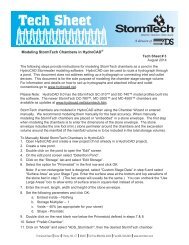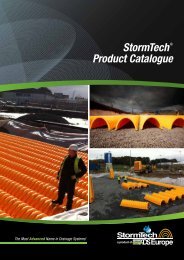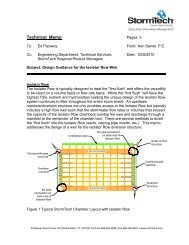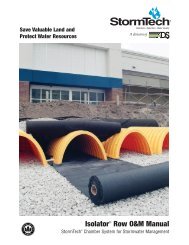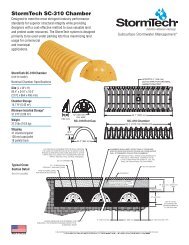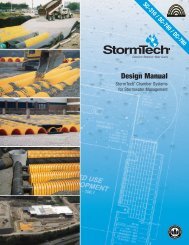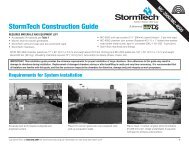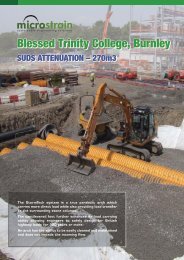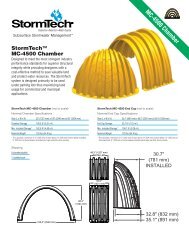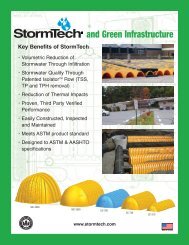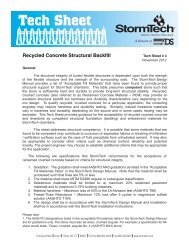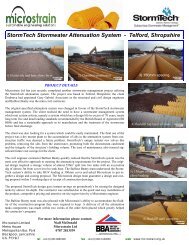Tech Sheet 2 - StormTech
Tech Sheet 2 - StormTech
Tech Sheet 2 - StormTech
You also want an ePaper? Increase the reach of your titles
YUMPU automatically turns print PDFs into web optimized ePapers that Google loves.
The equation for a rectangular weir is:<br />
HIGH FLOW<br />
BYPASS<br />
STRUCTURE<br />
WEIR<br />
H<br />
The relationship between bedding thickness and maximum allowable groundwater elevation is:<br />
Hgw<br />
4" HDPE<br />
UNDERDRAIN (TYP.)<br />
t<br />
The bulk density of the open graded stone bedding materials varies from about 75 lbs/ft 3 to over<br />
100 lbs/ft 3 . Without specific bulk density information for the stone actually used, Storm<strong>Tech</strong><br />
recommends using not more than 75 lbs/ft 3.<br />
* The consulting engineer may apply a lower or higher safety factor.<br />
H = (Q / (Cd x L)) 2/3<br />
Where: Q = flow over the weir (cfs)<br />
Cd = discharge coefficient = 3.3<br />
H = Depth of flow over crest (ft)<br />
L = length of weir (ft)<br />
Page 4 of 6<br />
<strong>Tech</strong> <strong>Sheet</strong> #2<br />
In a typical downstream overflow design, the designer may incorporate one or more low flow orifices into<br />
the high flow weir wall. The weir crest is established as described above but hydraulic losses from the inlet<br />
to chamber to the outlet structure may need to be considered. Losses may be factored in by lowering the<br />
weir crest or increasing the liner freeboard.<br />
Buoyancy Storm<strong>Tech</strong> recommends against installing lined chamber systems below groundwater.<br />
Although the total weight of a chamber system generally exceeds the buoyant force, a limiting stability<br />
condition may result when the buoyant pressure exceeds the resistance pressure directly under the<br />
chamber. This could result in a heave of the bedding under the chamber leading to instability. To prevent<br />
adverse impacts from ground water, where gravity discharge is possible, Storm<strong>Tech</strong> recommends the<br />
installation of an underdrain system under the liner. Where there is a potential buoyant force, Storm<strong>Tech</strong><br />
recommends a sufficient stone bedding thickness, such that the weight of stone exceeds the maximum<br />
buoyant force.<br />
The bedding thickness calculation is simplified by ignoring any structural contribution from the liner and<br />
reinforcing material and considering only the weight of the stone in the thinnest area of the bedding, which<br />
is located under the chamber.<br />
Hgw x (62.4 lb/ft 3 ) = ( stone x t) / SF<br />
Where:<br />
Hgw = height of groundwater above liner bottom<br />
(inches)<br />
stone = bulk density of bedding stone (lb/ft 3 )<br />
t = thickness of stone bedding (inches)<br />
SF = safety factor (1.5 typical minimum)*




